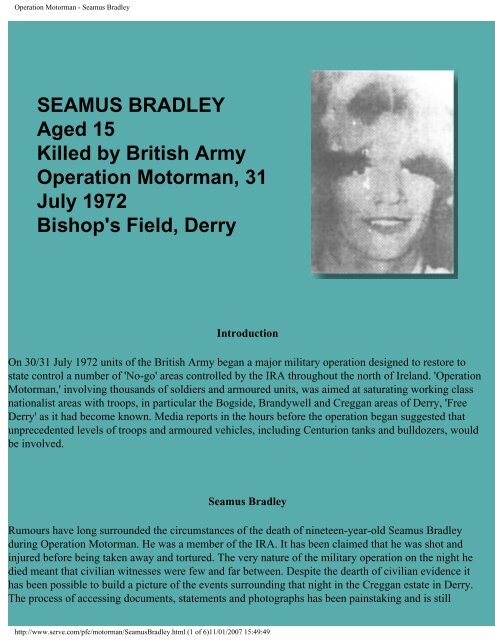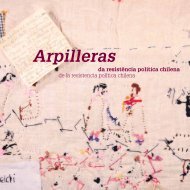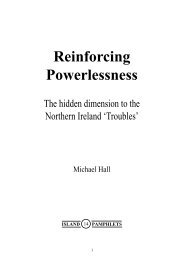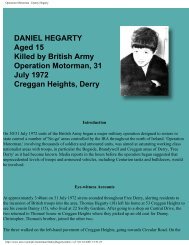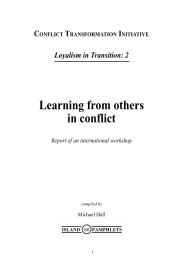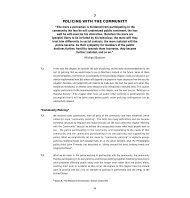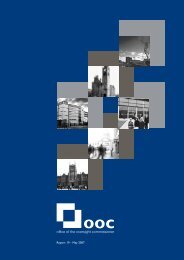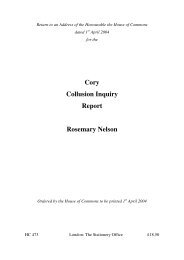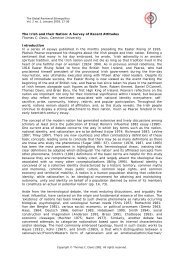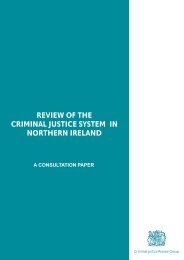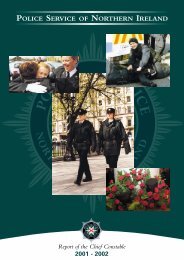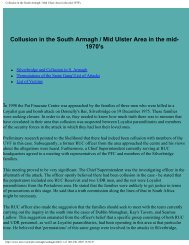Operation Motorman - Seamus Bradley - CAIN
Operation Motorman - Seamus Bradley - CAIN
Operation Motorman - Seamus Bradley - CAIN
Create successful ePaper yourself
Turn your PDF publications into a flip-book with our unique Google optimized e-Paper software.
<strong>Operation</strong> <strong>Motorman</strong> - <strong>Seamus</strong> <strong>Bradley</strong>SEAMUS BRADLEYAged 15Killed by British Army<strong>Operation</strong> <strong>Motorman</strong>, 31July 1972Bishop's Field, DerryIntroductionOn 30/31 July 1972 units of the British Army began a major military operation designed to restore tostate control a number of 'No-go' areas controlled by the IRA throughout the north of Ireland. '<strong>Operation</strong><strong>Motorman</strong>,' involving thousands of soldiers and armoured units, was aimed at saturating working classnationalist areas with troops, in particular the Bogside, Brandywell and Creggan areas of Derry, 'FreeDerry' as it had become known. Media reports in the hours before the operation began suggested thatunprecedented levels of troops and armoured vehicles, including Centurion tanks and bulldozers, wouldbe involved.<strong>Seamus</strong> <strong>Bradley</strong>Rumours have long surrounded the circumstances of the death of nineteen-year-old <strong>Seamus</strong> <strong>Bradley</strong>during <strong>Operation</strong> <strong>Motorman</strong>. He was a member of the IRA. It has been claimed that he was shot andinjured before being taken away and tortured. The very nature of the military operation on the night hedied meant that civilian witnesses were few and far between. Despite the dearth of civilian evidence ithas been possible to build a picture of the events surrounding that night in the Creggan estate in Derry.The process of accessing documents, statements and photographs has been painstaking and is stillhttp://www.serve.com/pfc/motorman/<strong>Seamus</strong><strong>Bradley</strong>.html (1 of 6)11/01/2007 15:49:49
<strong>Operation</strong> <strong>Motorman</strong> - <strong>Seamus</strong> <strong>Bradley</strong>incomplete. The fact file below is largely based on documentation available from the Public RecordsOffice, including statements from the RUC and the British Army Special Investigation Branch. As usualmore questions have been raised than answered.As the British Army moved into the no-go areas in Derry on the night of July 31 1972 a unit of theRoyal Scots, Sp Coy, took up position behind a hedge at No.3 Linsfort Drive in Creggan. The time wasapproximately 4.15am. Half an hour later a soldier in this unit, identified only as soldier "A", claimedthat he saw <strong>Seamus</strong> <strong>Bradley</strong> through the 'Starsight' scope on his rifle. According to soldier A <strong>Seamus</strong>had broken away from a group of ten people at Central Drive shops and run towards the trees in Bishop'sField. This person was carrying what appeared to be a Thompson submachine gun, again according tosoldier A. No reference is made to any other persons. In fact he is clear that only one person hadbroken away from the group. According to his statement the alleged gunman stayed at the base of thetree for some three minutes before climbing up into the branches.Soldier "B", who was in charge of the unit, was informed and claimed in his later statement that he thenalso used the Starsight scope and identified a further two men standing at the base of a tree in theBishop's Field area. He then ordered his subordinate, soldier A, to open fire.Soldier A admits to then firing four shots. The distance was some 175 metres. He claims that onlythe third shot (ankle wound) and fourth shot (thigh wound) hit <strong>Seamus</strong> <strong>Bradley</strong>. According tohttp://www.serve.com/pfc/motorman/<strong>Seamus</strong><strong>Bradley</strong>.html (2 of 6)11/01/2007 15:49:49
<strong>Operation</strong> <strong>Motorman</strong> - <strong>Seamus</strong> <strong>Bradley</strong>soldier B the two men at the base of the tree disappeared when the wounded <strong>Seamus</strong> <strong>Bradley</strong> fell to theground following the shooting. Soldier A makes no mention of any other individuals. <strong>Seamus</strong> <strong>Bradley</strong>,according to the British Army version, was now lying with two gunshot wounds in a hollow near thebase of the tree. He was out of sight but surrounded.At approximately 5.45am, almost an hour later, a soldier identified only as soldier "C" was incommand of a Saracen parked at the junction of Linsfort Drive/Central Drive when he received an orderfrom his platoon commander to search for a "body and weapon" in an area bounded by Bligh's Lane,Iniscarn Rd, Linsfort Drive and Central Drive. He claims that he secured the area and then, accompaniedby soldier "F", he approached the wounded man, who was approximately 10 yards from the tree. SoldierC said: "'come on boy'. <strong>Seamus</strong> <strong>Bradley</strong> then turned and said 'I'm hit Jock...' As we were lifting him intothe Saracen he said 'Kelly, Kelly, don't leave me...' Once we started moving the person he asked forsome water and never spoke again. On arrival at St Peters School the person was dead... On my arrival atthe scene I noticed that the person was wounded in his left thigh and left foot. It was about 10 minuteslater when I arrived at St Peters School and saw the Medical Officer". Soldier C claims that a search fora weapon was made before leaving the scene but none was found.In a statement provided to the British Army Special Investigation Branch a Soldier D states that he wasthe Regimental Medical Officer with the 2nd Battalion The Royal Green Jackets. At "approx. 5.55am"he was in a Saracen ambulance in the grounds of St Peters School when a Royal Scots unit arrived in asecond Saracen with a "civilian in the back". He certified that the man was dead and ordered the body tobe taken into the school. According to his statement he asked for a civilian ambulance to be called which"arrived at least half an hour later". According to hospital records the bodies of both <strong>Seamus</strong> <strong>Bradley</strong>and Danny Hegarty were admitted to the morgue at Altnagelvin at 7.10am on the morning of July 31.Later that same day two Corporals from the Army Special Investigation Branch took statementsfrom soldiers A, B, C and D, the Medical Officer. The official version of the incident appearedclear cut. A gunman, who the IRA admitted was a member, had appeared during a militaryoperation carrying a submachine gun. Four shots had been fired at him and soldier A 'claimed'two hits. The man, <strong>Seamus</strong> <strong>Bradley</strong>, died from his wounds.Several hours after the statements had been taken the State Pathologist Dr Thomas Marshall carried outa post-mortem examination of the body of <strong>Seamus</strong> <strong>Bradley</strong>. Death was as a result of a bullet wound thathad severed the left femoral artery, i.e. the wound to the upper left thigh. The fourth shot. The report ofthe autopsy, which has only recently been made available, revealed startling additionalinformation. "He had been shot at least four times" according to the report. The autopsy left openthe possibility that a fifth wound to the left ankle area was a further gunshot wound or was caused byone of the four bullets which had struck his body. In addition reference is made to bruises on hisnose, lips and chin and "some bruising with a vertical linear pattern on the chin and the front ofhis neck." The autopsy findings were completely at odds with the version of events portrayed bysoldiers on the ground.It is highly unlikely that the four, and possibly five, gunshot wounds inflicted on <strong>Seamus</strong> <strong>Bradley</strong>http://www.serve.com/pfc/motorman/<strong>Seamus</strong><strong>Bradley</strong>.html (3 of 6)11/01/2007 15:49:49
<strong>Operation</strong> <strong>Motorman</strong> - <strong>Seamus</strong> <strong>Bradley</strong>could have resulted from the original shots fired by soldier A.There are a number of reasons for stating this.1) Soldier A did not even claim four 'hits'. There is no legal reason why he should claim two asopposed to four 'hits' against an alleged 'gunman'.2) It would be extraordinary that all four shots would be accurate given the range, 175 metres, andequally extraordinary for a man to stay upright long enough for such wounds to be inflicted whileit was claimed that he was standing on the bough of a tree.3) Soldier C claims that <strong>Seamus</strong> spoke when he and Soldier F put the injured man into theSaracen. This would confirm that he was alive at least one full hour later. In the unlikely eventthat all the wounds confirmed at the autopsy were sustained while 'in the tree' it must be doubtedwhether he would still have been alive an hour later given the extent of the wounds. (Dr RaymondMc Clean has viewed the autopsy photographs and studied the documents and this is also hisopinion.) In other words, if he was alive an hour later it is improbable that he had sustained morethan the two wounds claimed by soldier A.Was <strong>Seamus</strong> <strong>Bradley</strong> armed?Soldier C admits that a search of the area was carried out sometime after 5.45am but no weapon wasfound. Was there ever a weapon?1) In his statement Soldier A states that his unit, Sp Coy Royal Scots, was ordered to "secure andmaintain a firm base covering the waste ground between the roads, Blighs Lane, Iniscarn Road, LinsfortDrive and Central Drive." Their orders were to remain at this location in other words. From the time ofthe shooting, approx. 4.55am, until Soldier C moved in with his group to arrest the injured manafter 5.45am the area, which soldiers presumably believed contained an armed, dangerous andwounded man, was under close observation. Anyone who attempted to retrieve a weapon in suchcircumstances would have been shot on sight.2) When Soldier C did approach the wounded man sometime after 5.45am it was already dawn, allowingfor a more thorough search of the area. No weapon was found.3) As <strong>Operation</strong> <strong>Motorman</strong> continued the entire Creggan Estate came under the complete controlof the British Army rendering absurd any possibility that a weapon could have been recoveredfrom 'secured' waste ground in the middle of the estate.This leaves open two possibilities. The first is that no weapon existed. This is consistent with the policyhttp://www.serve.com/pfc/motorman/<strong>Seamus</strong><strong>Bradley</strong>.html (4 of 6)11/01/2007 15:49:49
<strong>Operation</strong> <strong>Motorman</strong> - <strong>Seamus</strong> <strong>Bradley</strong>of the IRA at the time which was, quite literally, to 'melt into the background' during the militaryoperation. No soldiers received gunshot wounds during that morning for instance. The second possibilityis that the two men who are alleged by Soldier B to have been standing at the base of the tree took theweapon when they disappeared after the shooting. Soldier A, using a Starsight Scope, made no referenceto more than one person breaking off from the original group at the shops, to anyone near the tree or toany individuals running off afterwards. Since Soldier A refers to <strong>Seamus</strong> spending some three minutes atthe base of the tree before climbing it two inferences can be drawn. The first is that he had a clear viewof that immediate area. The second is that it is highly unlikely that he would have told his superior thatone gunman was at that location if there had been in reality three men, one of whom was carrying a gun.In addition, statements provided to the Pat Finucane Centre by individuals who were with <strong>Seamus</strong><strong>Bradley</strong> at the shops shortly beforehand concur with the claim that <strong>Seamus</strong> broke off alone and unarmedfrom a group of youths and made his own way down towards Bishops Field.This raises the question as to why Soldier B, who ordered the shooting, claimed the existence of afurther two individuals at the base of the tree in a statement taken some seven hours later? It is notunreasonable to assume that the man who was legally responsible for the killing realised the need toaccount for the absence of a weapon. Did he intend to claim that the phantom gun disappeared with thephantom individuals alleged to be accompanying <strong>Seamus</strong>?Two factors united against the truth ever emerging in this case: 1972 saw the highest death toll of anyyear of the conflict with 496 people losing their lives. In addition <strong>Seamus</strong> was a member of the IRA. Forsome this justified any use of lethal force regardless of the morality or legality of the individual killing.Yet the death of <strong>Seamus</strong> <strong>Bradley</strong> raises a number of disturbing issues.Wounds InflictedGiven that it was extremely unlikely that all the gunshot wounds were inflicted by soldier A theimplication is that further wounds were inflicted, possibly from close range, on a wounded manalready in custody. Did this occur while he was lying in the field or later when he was taken away in aSaracen? What explanation is there for the bruising to the area of the neck and face and in particular forthe finding of "some bruising with a vertical linear pattern on the chin and the front of his neck."?According to the autopsy findings bullets entered his body from two different directions. In addition thebullet wound to the left armpit could only have been inflicted if the left arm was raised. Why didsoldier A not anticipate a possible discrepancy between his statement and the autopsy findings?Possibly because he did in fact only wound <strong>Seamus</strong> <strong>Bradley</strong> twice and was unaware of whatanother unit did later. His and the other statements were taken before the autopsy was carried out.Given the scale of the military operation with multiple regiments and units involved it may well haveproved both difficult and unnecessary to get a consistent version of what happened. In any case no-onewas asking awkward questions.http://www.serve.com/pfc/motorman/<strong>Seamus</strong><strong>Bradley</strong>.html (5 of 6)11/01/2007 15:49:49
<strong>Operation</strong> <strong>Motorman</strong> - <strong>Seamus</strong> <strong>Bradley</strong>To date the RUC has been unable to furnish the PFC with any witness statements taken fromcivilians living in the area. None. From the available information it also appears that the RUC didnot even interview the soldiers involved. Significantly, in August 2000, the RUC admitted in aletter to the PFC that swab and forensic tests from the body and clothes of <strong>Seamus</strong> <strong>Bradley</strong> hadtested negative, ie <strong>Seamus</strong> was unarmed when he was shot.The RUC has conceded that documentation and photographs will be provided to ballistics and woundsexperts. Until that happens the jury at the inquest have the last word. They passed an Open Verdict onthe death of <strong>Seamus</strong> <strong>Bradley</strong>.<strong>Motorman</strong>sectionReturn tohome pagehttp://www.serve.com/pfc/motorman/<strong>Seamus</strong><strong>Bradley</strong>.html (6 of 6)11/01/2007 15:49:49


